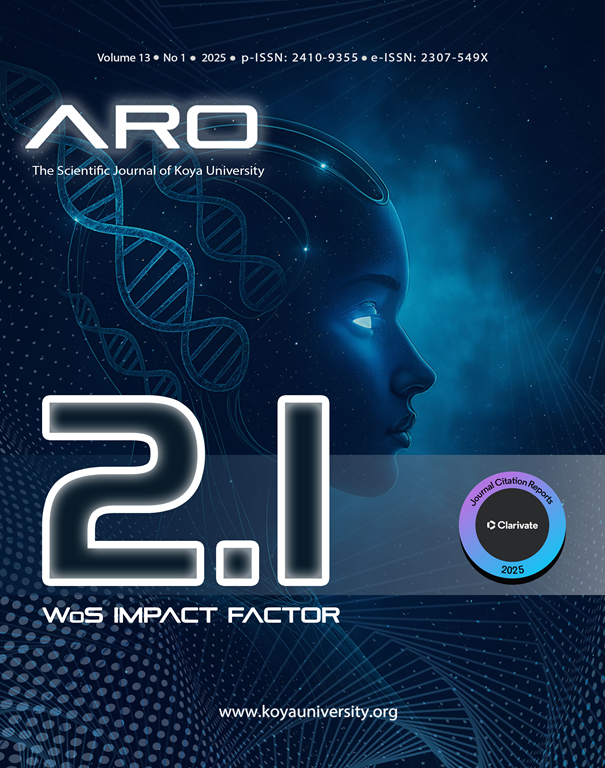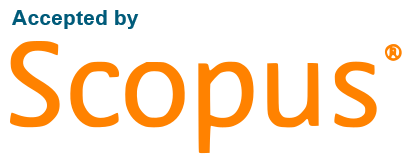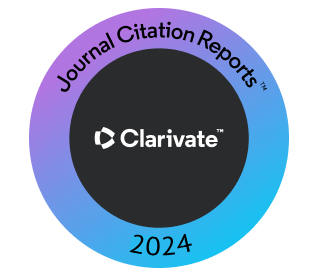The Improved Kurdish Dialect Classification Using Data Augmentation and ANOVA-Based Feature Selection
DOI:
https://doi.org/10.14500/aro.11897Keywords:
1D convolutional neural network, Data augmentation, Feature selection, Kurdish dialect identification, Sound featureAbstract
Analyzing dialects in the Kurdish language proves to be tough because of the tiny phonetic distinctions among the dialects. We applied advanced methods to enhance the precision of Kurdish dialect classification in this research. We examined the dataset’s stability and variation through the use of time-stretching and noise-augmenting methods. Analysis of variance (ANOVA) filter approach is applied to improve feature selection (FS) more efficiently and highlight the most relevant features for dialect classification. The ANOVA filter method ranks features based on the means from different dialect groups, which made FS better. To make dialect classification work better, a 1D convolutional neural network model was given a dataset that had ANOVA FS added to it. The model showed a very strong performance, reaching a remarkable accuracy of 99.42%. This noteworthy increase in accuracy beat former research with an accuracy of 95.5%. The findings demonstrate how combining time stretch and FS methods can improve the accuracy of Kurdish dialect classification. This project improves our understanding and implementation of machine learning in the field of linguistic diversity and dialectology.
Downloads
References
Abdul, Z.K., Al-Talabani, A., and Abdulrahman, A.O. 2016. A new feature extraction technique based on 1D local binary pattern for gear fault detection. Shock and Vibration, 2016, p. 8538165. DOI: https://doi.org/10.1155/2016/8538165
Abdullah, A.A., Abdulla, S.H., Toufiq, D.M., Maghdid, H.S., Rashid, T.A., Farho, P.F., & Asaad, A.T. 2024. NER-RoBERTa: Fine-Tuning RoBERTa for Named Entity Recognition (NER) within low-resource languages. arXiv preprint arXiv:2412.15252.
Aguiar, R.L., Costa, Y.M., and Silla, C.N. 2018. Exploring data augmentation to improve music genre classification with convnets. In: 2018 International Joint Conference On Neural Networks (IJCNN). IEEE, United States, pp. 1-8. DOI: https://doi.org/10.1109/IJCNN.2018.8489166
Al-Onazi, B.B., Nauman, M.A., Jahangir, R., Malik, M.M., Alkhammash, E.H., and Elshewey, A.M. 2022. Transformer-based multilingual speech emotion recognition using data augmentation and feature fusion. Applied Sciences, 12, p. 9188. DOI: https://doi.org/10.3390/app12189188
Al-Talabani, A.K., Abdul, Z.K., and Ameen, A.A. 2017. Kurdish dialects and neighbor languages automatic recognition. ARO-The Scientific Journal of Koya University, 5, pp. 20-23. DOI: https://doi.org/10.14500/aro.10167
Bahari, M.H., Dehak, N., Burget, L., Ali, A.M., and Glass, J. 2014. Non-negative factor analysis of gaussian mixture model weight adaptation for language and dialect recognition. IEEE/ACM Transactions On Audio, Speech, and Language Processing, 22, pp. 1117-1129. DOI: https://doi.org/10.1109/TASLP.2014.2319159
Cheng, W.K., Khairuddin, I.M., Majeed, A.P.A., and Razman, M.A.M. 2020. The Classification of heart murmurs: The identification of significant time domain features. Mekatronika: Journal of Intelligent Manufacturing and Mechatronics, 2, pp. 36-43. DOI: https://doi.org/10.15282/mekatronika.v2i2.6748
Damskägg, E.P., and Välimäki, V. 2017. Audio time stretching using fuzzy classification of spectral bins. Applied Sciences, 7, p. 1293. DOI: https://doi.org/10.3390/app7121293
Das, A., Guha, S., Singh, P.K., Ahmadian, A., Senu, N., and Sarkar, R. 2020. A hybrid meta-heuristic feature selection method for identification of Indian spoken languages from audio signals. IEEE Access, 8, pp. 181432-181449. DOI: https://doi.org/10.1109/ACCESS.2020.3028241
Das, P.P., Allayear, S.M., Amin, R., and Rahman, Z. Bangladeshi dialect recognition using Mel frequency cepstral coefficient, delta, delta-delta and Gaussian mixture model. In: 2016 Eighth International Conference on Advanced Computational Intelligence (ICACI), IEEE, United States, pp. 359-364. DOI: https://doi.org/10.1109/ICACI.2016.7449852
Ghafoor, K.J., Rawf, K.M.H., Abdulrahman, A.O., and Taher, S.H. 2021. Kurdish dialect recognition using 1D CNN. ARO-The Scientific Journal of Koya University, 9, pp. 10-14. DOI: https://doi.org/10.14500/aro.10837
Hama Rawf, K.M., Abdulrahman, A.O., and Mohammed, A.A. 2024. Improved recognition of Kurdish sign language using modified CNN. Computers, 13, p. 37. DOI: https://doi.org/10.3390/computers13020037
Hu, H., Tan, T., and Qian, Y. Generative adversarial networks based data augmentation for noise robust speech recognition. In: 2018 IEEE International Conference on Acoustics, Speech and Signal Processing (ICASSP). IEEE, United States, pp. 5044-5048. DOI: https://doi.org/10.1109/ICASSP.2018.8462624
Kanda, N., Takeda, R., and Obuchi, Y. Elastic spectral distortion for low resource speech recognition with deep neural networks. In: 2013 IEEE Workshop on Automatic Speech Recognition and Understanding. IEEE, United States, pp. 309-314. DOI: https://doi.org/10.1109/ASRU.2013.6707748
Karim, S.H.T., Ghafoor, K.J., Abdulrahman, A.O., and Rawf, K.M.H. 2024. AMulti-feature fusion approach for dialect identification using 1D CNN. JOIV: International Journal on Informatics Visualization, 8, pp. 1246-1252. DOI: https://doi.org/10.62527/joiv.8.3.2146
Khamparia, A., Gupta, D., Nguyen, N.G., Khanna, A., Pandey, B., and Tiwari, P. 2019. Sound classification using convolutional neural network and tensor deep stacking network. IEEE Access, 7, pp.7717-7727. DOI: https://doi.org/10.1109/ACCESS.2018.2888882
Kupryjanow, A., and Czyzewski, A. 2012. A method of real-time non-uniform speech stretching. E-Business and Telecommunications: International Joint Conference, ICETE 2011, Seville, Spain, July 18-21. Revised Selected Papers. Springer, Germany, pp. 362-373. DOI: https://doi.org/10.1007/978-3-642-35755-8_25
Li, X., Zhang, W., Ding, Q., and Sun, J.Q. 2020. Intelligent rotating machinery fault diagnosis based on deep learning using data augmentation. Journal of Intelligent Manufacturing, 31, pp.433-452. DOI: https://doi.org/10.1007/s10845-018-1456-1
Lounnas, K., Lichouri, M., and Abbas, M. 2022. Analysis of the effect of audio data augmentation techniques on phone digit recognition for algerian arabic dialect. In: 2022 International Conference on Advanced Aspects of Software Engineering (ICAASE). IEEE, United States, pp. 1-5. DOI: https://doi.org/10.1109/ICAASE56196.2022.9931574
Ma, R., Tao, P., and Tang, H. 2019. Optimizing data augmentation for semantic segmentation on small-scale dataset. In: Proceedings of the 2nd International Conference on Control and Computer Vision, pp. 77-81. DOI: https://doi.org/10.1145/3341016.3341020
Moreno-Barea, F.J., Jerez, J.M., and Franco, L. 2020. Improving classification accuracy using data augmentation on small data sets. Expert Systems with Applications, 161, DOI: https://doi.org/10.1016/j.eswa.2020.113696
Mulahuwaish, A., Gyorick, K., Ghafoor, K.Z., Maghdid, H.S., and Rawat, D.B. 2020. Efficient classification model of web news documents using machine learning algorithms for accurate information. Computers and Security, 98, p. 102006. DOI: https://doi.org/10.1016/j.cose.2020.102006
Nguyen, T.S., Stueker, S., Niehues, J., and Waibel, A. 2020. Improving sequenceto-sequence speech recognition training with on-the-fly data augmentation. In: ICASSP 2020-2020 IEEE International Conference on Acoustics, Speech and Signal Processing (ICASSP). IEEE, United States, pp. 7689-7693. DOI: https://doi.org/10.1109/ICASSP40776.2020.9054130
Nugroho, K., and Noersasongko, E. 2022. Enhanced Indonesian ethnic speaker recognition using data augmentation deep neural network. Journal of King Saud University-Computer and Information Sciences, 34, pp. 4375-4384. DOI: https://doi.org/10.1016/j.jksuci.2021.04.002
Peddinti, V., Chen, G., Manohar, V., Ko, T., Povey, D., and Khudanpur, S. 2015. Jhu aspire system: Robust lvcsr with tdnns, ivector adaptation and rnn-lms. In: 2015 IEEE Workshop on Automatic Speech Recognition and Understanding (ASRU). IEEE, United States, pp. 539-546. DOI: https://doi.org/10.1109/ASRU.2015.7404842
Ragni, A., Knill, K.M., Rath, S.P., and Gales, M.J. Data augmentation for low resource languages. In: Interspeech 2014: 15th Annual Conference of the International Speech Communication Association, 2014. International Speech Communication Association (ISCA), pp. 810-814. DOI: https://doi.org/10.21437/Interspeech.2014-207
Rawf, K.M.H., Karim, S.H.T., Abdulrahman, A.O., and Ghafoor, K.J. 2024. Dataset for the recognition of Kurdish sound dialects. Data in Brief, 53, p. 1. DOI: https://doi.org/10.1016/j.dib.2024.110231
Rebai, I., Benayed, Y., Mahdi, W., and Lorré, J.P. 2017. Improving speech recognition using data augmentation and acoustic model fusion. Procedia Computer Science, 112, pp. 316-322. DOI: https://doi.org/10.1016/j.procs.2017.08.003
Rituerto-González, E., Mínguez-Sánchez, A., Gallardo-Antolín, A., and PeláezMoreno, C. 2019. Data augmentation for speaker identification under stress conditions to combat gender-based violence. Applied Sciences, 9, p. 2298. DOI: https://doi.org/10.3390/app9112298
Salamon, J., and Bello, J.P. 2017. Deep convolutional neural networks and data augmentation for environmental sound classification. IEEE Signal Processing Letters, 24, pp. 279-283. DOI: https://doi.org/10.1109/LSP.2017.2657381
Sangwan, P., Deshwal, D., and Dahiya, N. (2021). Performance of a language identification system using hybrid features and ANN learning algorithms. Applied Acoustics, 175, p. 107815. DOI: https://doi.org/10.1016/j.apacoust.2020.107815
Shetty, N., Patnaik, L., and Prasad, N. 2022. Emerging research in computing, information, communication and applications proceedings of ERCICA 2022. In: Proceedings of ERCICA, p. 1. DOI: https://doi.org/10.1007/978-981-16-1338-8
Tu, Z., Liu, B., Zhao, W., Yan, R., and Zou, Y. 2023. Afeature fusion model with data augmentation for speech emotion recognition. Applied Sciences, 13, p. 4124. DOI: https://doi.org/10.3390/app13074124
Tubishat, M., Abushariah, M.A., Idris, N., and Aljarah, I. 2019. Improved whale optimization algorithm for feature selection in Arabic sentiment analysis. Applied Intelligence, 49, pp. 1688-1707. DOI: https://doi.org/10.1007/s10489-018-1334-8
Turab, M., Kumar, T., Bendechache, M., and Saber, T. 2022. Investigating multi-feature selection and ensembling for audio classification. arXiv preprint arXiv:2206.07511. DOI: https://doi.org/10.5121/ijaia.2022.13306
Wu, T., Duchateau, J., Martens, J.P., and Van Compernolle, D. 2010. Feature subset selection for improved native accent identification. Speech Communication, 52, pp. 83-98. DOI: https://doi.org/10.1016/j.specom.2009.08.010
Zheng, Q., Yang, M., Tian, X., Jiang, N., and Wang, D. 2020. A full stage data augmentation method in deep convolutional neural network for natural image classification. Discrete Dynamics in Nature and Society, 2020, p. 4706576. DOI: https://doi.org/10.1155/2020/4706576
Zhou, H., Wang, X., and Zhu, R. 2022. Feature selection based on mutual information with correlation coefficient. Applied Intelligence, 52, pp. 5457-5474. DOI: https://doi.org/10.1007/s10489-021-02524-x
Downloads
Published
How to Cite
Issue
Section
License
Copyright (c) 2025 Karzan J. Ghafoor, Sarkhel H. Karim, Karwan M. Hama Rawf, Ayub O. Abdulrahman

This work is licensed under a Creative Commons Attribution-NonCommercial-ShareAlike 4.0 International License.
Authors who choose to publish their work with Aro agree to the following terms:
-
Authors retain the copyright to their work and grant the journal the right of first publication. The work is simultaneously licensed under a Creative Commons Attribution License [CC BY-NC-SA 4.0]. This license allows others to share the work with an acknowledgement of the work's authorship and initial publication in this journal.
-
Authors have the freedom to enter into separate agreements for the non-exclusive distribution of the journal's published version of the work. This includes options such as posting it to an institutional repository or publishing it in a book, as long as proper acknowledgement is given to its initial publication in this journal.
-
Authors are encouraged to share and post their work online, including in institutional repositories or on their personal websites, both prior to and during the submission process. This practice can lead to productive exchanges and increase the visibility and citation of the published work.
By agreeing to these terms, authors acknowledge the importance of open access and the benefits it brings to the scholarly community.
Accepted 2025-02-27
Published 2025-03-07
















 ARO Journal is a scientific, peer-reviewed, periodical, and diamond OAJ that has no APC or ASC.
ARO Journal is a scientific, peer-reviewed, periodical, and diamond OAJ that has no APC or ASC.